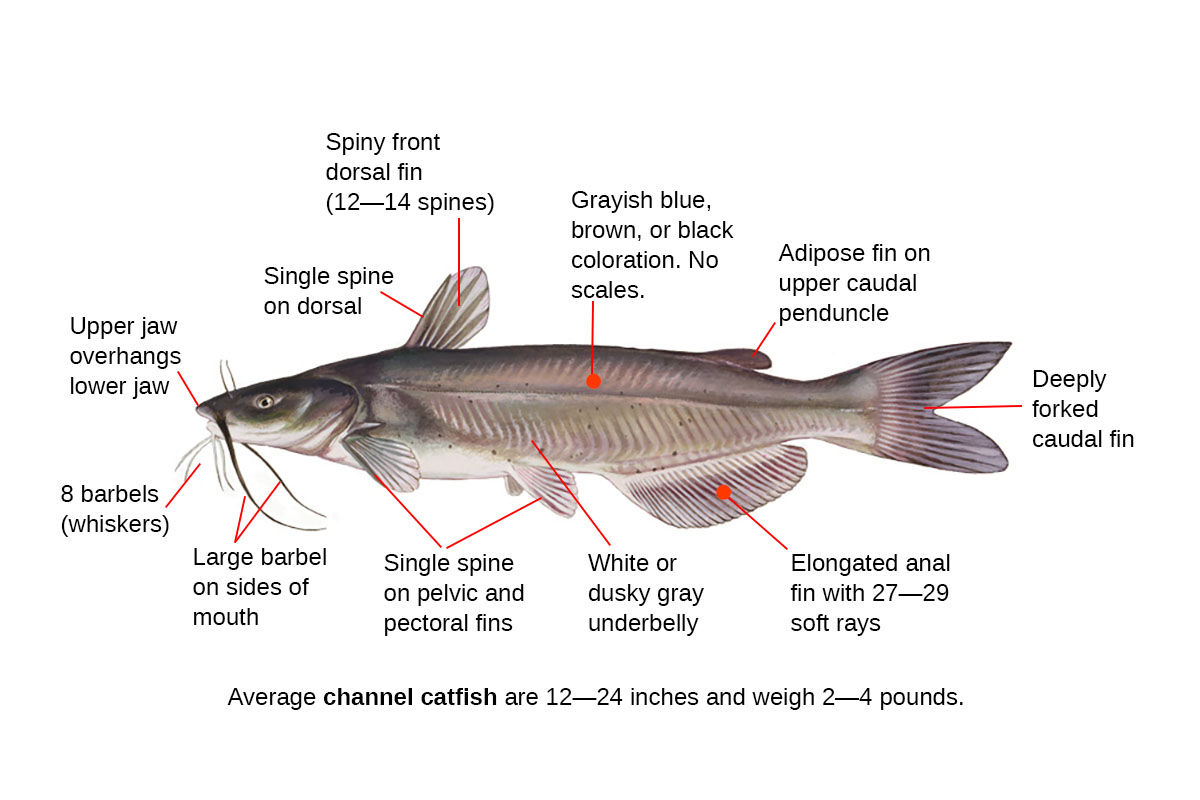Channel Catfish usually feed at the bottom of lakes, rivers and ponds, but occasionally feed at the surface. The best bait for catching Channel catfish includes cheese-based fibrous bait, chicken liver, shrimp, minnows, worms and stinkbait. The best methods for catching Channel cats include bottom fishing, still fishing and drift fishing.

Habitat: Lake, River, Stream
How to identify Channel Catfish
Like other catfish species, channel catfish have an elongated, tubular body with barbels (whiskers), an adipose fin on the upper caudal penduncle, glandular mucas secreting skin that lacks scales, and spined pectoral fins. Channel cats also have several identifiable characteristics that help distinguish them from other catfish species.

The head and back of a channel catfish is most often grayish blue, brown, black, or solid gray. Moving from the top of the back down the body toward the belly coloration lightens considerable. The underbelly of a channel catfish will range from a dusky gray to soft white. Channel catfish coloration will vary throughout their life and is impacted by a variety of environmental factors including water clarity, color, and depth. A channel cat that lives in turbid, stained water will often have different coloration than a channel fish found in clear water.
The upper jaw of a channel catfish overhangs the lower jaw creating a slight downward point to the mouth. The mouth has eight barbels. On either side of the mouth there is a longer dark gray or black barbel, with two smaller barbels above the mouth. There are four additional barbels below the mouth on the chin. On juvenile catfish the lower four barbels are white but become darker as the fish matures. Although ominous in appearance, barbels are a sense organ used for detecting food and do not present a danger to angler.
The dorsal fin on a channel catfish has a single spine followed by 6—7 soft ray. When the catfish becomes alarmed the dorsal spine erects. The tip of the dorsal spin is sharp and is painful when poked. As channel catfish grow older, the dorsal spin becomes blunt. The pectoral fin on channel catfish has a single spine followed by 7—9 soft rays.
The caudal (tail) fin on channel catfish is deeply forked and has dark coloration. The pelvic fin has one spine and 8—9 soft rays. The adipose fin on the upper caudal penduncle has no spines or rays. The anal fin on channel catfish is elongated with 27—29 soft rays. Counting the number of anal fin rays on a channel catfish is the most definitive way to distinguish it from other catfish species such as blue catfish and white catfish, which have 30-36 rays and 19-23 rays respectively on their anal fins.
Channel catfish are distinguishable from bullhead and flathead catfish by their tail fin. Where the tail fin on a channel catfish is forked, the tail fin on both a bullhead and flathead catfish is square or rounded.
Adult channel catfish average between 12 and 24 inches and weight 2 to 4 pounds. However, catfish can reach up to 48″ in length and weigh more than 50 pounds. The largest channel catfish on record—caught in Santee-Cooper Reservoir in South Carolina—weighed in at 58 pounds and measured just shy of 48 inches.
Identifying characteristics:
- 8 barbels (whiskers)
- A large barbel on either side of the mouth
- Adipose fin on the upper caudal penduncle
- No scales
- Single spine on dorsal, pectoral and pelvic fins
- Grayish blue, brown, black, or gray coloration
- White or dusky gray underbelly
- Upper jaw slightly overhangs lower jaw
- Deeply forked tail fin
- Elongated anal fin with 27—29 soft rays
Average channel catfish are 12—24 inches and weigh 2—4 pounds.
Where to catch Channel Catfish
Channel catfish can be found in southern Canada, the U.S., and northern Mexico. They are especially abundant in the central-eastern U.S. Sparse populations were introduced to the western coastal regions of the U.S. and east of the Appalachians. They are finicky, preferring the sand and gravel bottoms of big lakes and rivers. As spawning season hits, they move to streams and creeks.

The following are habitats where you can catch Channel Catfish:
- Freshwater Weed Beds
- Gradual Shores
- Lake and Pond Fishing Holes
- Inlets and Outlets
- Open Water
- Piers, Docks and Pilings
- Shoreline Shallows
- Springs Holes
- Sunken Objects
- Walkways and Bridges
How to catch Channel Catfish
Channel catfish feed mainly during the night. They feed on insects, other small fish, and crayfish. To fish for channel catfish, it is advisable to have an extra-long fishing rod to help flip and pitch them into the boat. The rod should also be very sturdy so it can handle the weight of these heavy fish. Channel catfish have hard mouths, so a sharp hook is also a must. Many anglers opt for treble hooks to keep these fish from escaping. Catfish rigs can also help present bait in a fashion to entice channel catfish to bite. Channel catfish are very slimy due to their lack of scales, so it is important to grip them firmly before attempting to remove the hook.
The following are effective fishing methods and techniques for catching Channel Catfish:
Best Lures, Bait & Tackle to catch Channel Catfish
The channel catfish has a very good sense of smell, so strong scents are great for attracting them. Cheese-based baits work especially well, as do minnows, worms, and stinkbait.
The following are fishing lures, bait and tackle that can be used to catch Channel Catfish:



